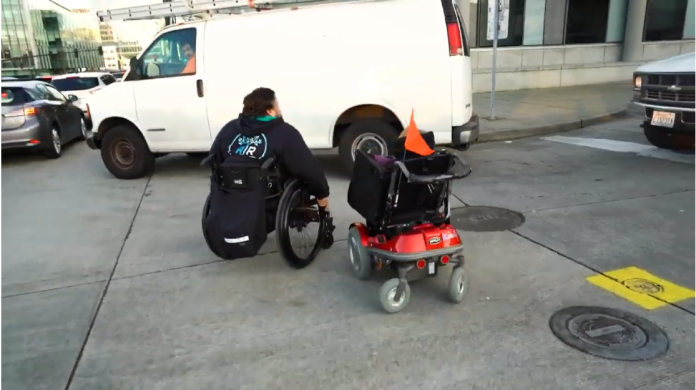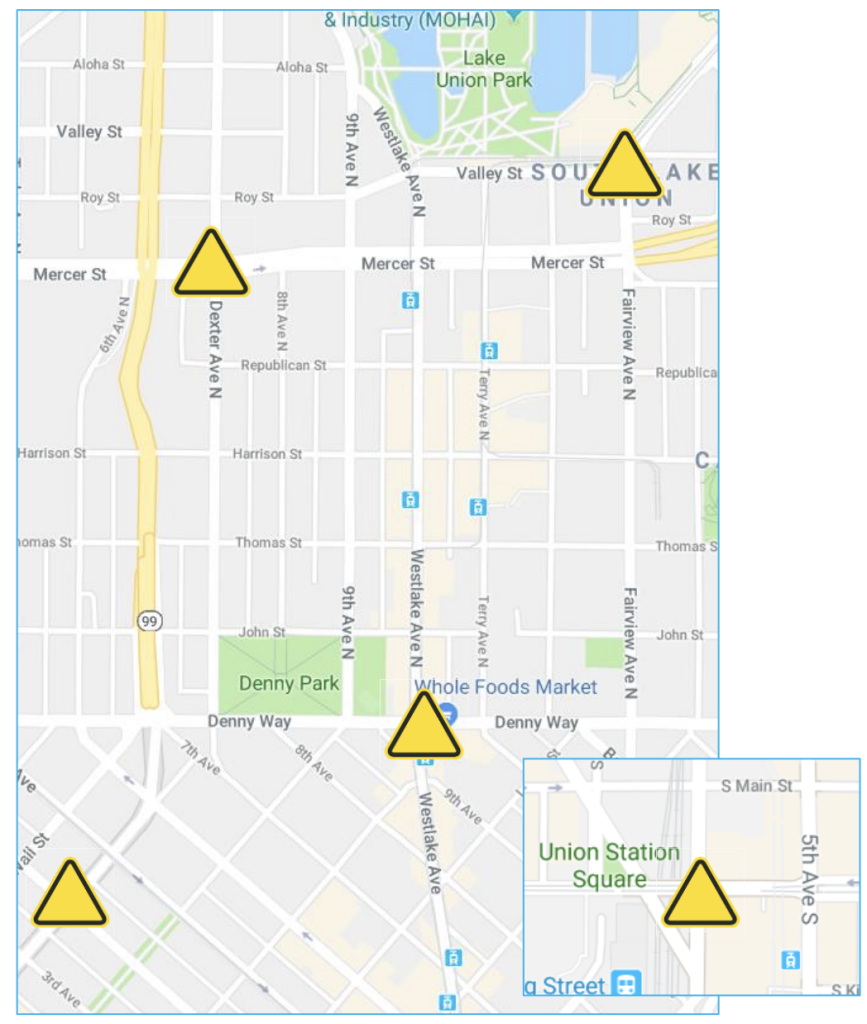
Automated camera enforcement of motorists blocking intersections, transit-only lanes, bus stops, intersections, and even emergency vehicle entries and exits could finally come to Washington. Cities and counties would be authorized under House Bill 1793 to freely designate new locations for those purposes, allowing them to send fines to violators and hopefully result in clearer crosswalks for people using them and improved transit speed and reliability. Motorists at busy intersections could also get some measure of relief by reduced blockages at intersections.
A transportation bill rooted in safety and fairness
On Wednesday, Representative Joe Fitzgibbon (D-Seattle) introduced the long-awaiting bill into the House of Representatives. “It’s not just about transit lanes; it’s also about blocking the box,” he said, adding automated camera enforcement would do a better job than a police officer pulling someone over in traffic.
The bill could lead to higher traffic safety compliance, Representative Fitzgibbon said. The impetus for this bill came from issues he has seen in areas of his district like West Seattle where buses often are delayed by motorists. He also thinks that the bill could help first responders and people with disabilities, too.
Rooted in Rights, a local group dedicated to disability rights and accessibility issues, has joined Transportation Choices Coalition in advocating for the bill. They see intersection and crosswalk blocking as a serious problem for people who have mobility challenges, and in many cases a safety threat. The group recently visited Mercer Street in Seattle to demonstrate why crosswalk and intersection violations are a problem. People with wheelchairs are often unable to snake through clogged cars in a safe manner, which means unfairly making people with mobility challenges wait longer to cross a street or taking matters into their own hands, risking life and limb.
“Obstructed crosswalks are dangerous for everyone. Anytime drivers block the box they put people at risk, and for disabled pedestrians that risk is disproportionately greater,” said Clark Matthews, Lead Producer for Rooted in Rights. “Studies like the one from Georgetown have shown that the majority of car-pedestrian deaths happen to those in wheelchairs, often at intersections.”
“For those of us who rely on curb ramps to get in and out of an intersection–folks with disabilities who use wheelchairs, walkers, and mobility scooters, families with children and strollers, employees making deliveries with carts–cars blocking access to curb ramps at intersections block our access and threaten our safety,” Matthews said. “Blocking intersections is a mobility issue as well as a safety issue–there’s no way to ‘just go around’ a driver blocking the only ramp out of an intersection. As we said in the video, when drivers block the box, they block us out–especially those of us with disabilities.”
“This legislation hits on two areas impacting safety and mobility: blocked intersections and crosswalks, and bus lane violations. By curbing these two issues, we can make it safer for people walking and using wheelchairs to cross the street, help ensure transit speed and reliability, clear the way for emergency vehicles and ease traffic flow for drivers,” said Kelsey Mesher, Advocacy Director for Transportation Choices Coalition.
“Blocking the box and using bus lanes for personal vehicles are already a violations in state code, but there are a whole host of issues with manual enforcement,” Mesher said. “This legislation does not mandate anything, it simply gives jurisdictions that need it the option to use automated enforcement.”
Last year’s bill failed, but this one has more promise
Last year, Representative Fitzgibbon and his colleague Representative Gael Tarleton (D-Seattle) tried to pass a different version of the bill, which would have limited the scope of automated camera enforcement to transit-only lanes in Seattle. The authorization also would have only been on a temporary basis for two years as a pilot program and limited to three corridors. The bill made it out of committee in its slimmed down version, but never ended up getting traction to move to a floor vote in the lower chamber, let alone consideration by the upper chamber.
This year’s bill, however, is broader in scope and has a better chance of passage due to the Democratic Party’s expanded control in both chambers and fewer skeptical legislators. Seven other Democrats have line up to signed on, including four who represent parts of Seattle, two who represent the Eastside, and Representative Jake Fey (D-Tacoma) who is Chair of the House Transportation Committee. That broad support is a good early indication, but that does not mean the bill will stay in the same form as its introduction.
Cameras could do more than unclog intersections
What is known, for now, is that bill would expand the power of local jurisdictions to use automated camera enforcement when motorists:
- Obstruct traffic by stopping;
- Obstruct intersections or crosswalks by stopping in them;
- Obstruct restricted emergency vehicle entries or exits by stopping or parking in them;
- Operate or stop in transit-only lanes; and
- Obstruct locations for passengers boarding and disembarking public transportation vehicles by stopping or parking in them.
The definition of “public transportation vehicle” in the bill is fairly broad, including buses, streetcars, trains, ferries, and other vehicles that a public transit agency–or their contractors–may use to move passengers.
Automated camera enforcement would also be allowed in a new location type: midblock on arterials. This is helpful particularly to transit-only lanes, but conceivably also for hospitals and bus stops that often are located midblock. Current law restricts automated camera enforcement to school speed zones, railroad crossings, and intersections with two arterials that have traffic lights and meet certain yellow light lengths.
Consistent with current law, local jurisdictions would need to carry out some analysis of need before deploying new automated camera enforcement locations. Local jurisdictions would also need to follow strict protocols for privacy protection, mailing infraction notices and fines to registered vehicle owners, properly signing automated camera enforcement locations, and providing notice of future enforcement at new locations at least 30 days before activation.
Seattle demonstrates the need for camera enforcement
Earlier this month, the Seattle City Council was briefed on lobbying efforts to get a transit-only lane and “block the box” camera enforcement bill passed and the benefits that the city could realize. Mayor Jenny Durkan said she personally lobbied state legislators. According to several case studies that the city transportation department reviewed, automated camera enforcement in other cities put a big dent in violation and congestion reduction in addition to increasing safety and transit speeds:
- Boston partnered with Waze to address “block the box” and double parking violations. That effort reduced congestion by 18% and travel delays by 20%.
- San Francisco instituted a pilot program for transit-only lane cameras, which pushed violations down by 55% and reduced collisions by 16%.
- In London, transit-only lane cameras have been in operation since 1997. Those cameras managed to increase transit speeds by 5%, saving passengers valuable time and transit agencies valuable service hours, a cited 2007 report found.

If authority is granted to implement automated enforcement cameras, Seattle would swiftly deploy technology, possibly at five key locations, including:
- Fairview Ave N and Valley Street;
- Dexter Ave N and Mercer Street;
- Denny Way and Westlake Avenue;
- Battery Street and Fourth Avenue; and
- S Jackson St and 4th Ave S.
This would help alleviate delay transit riders and other motorists. In fact, three of the proposed locations would benefit the streetcar lines while all five locations would benefit buses. It is possible that the city would expand implementation elsewhere, but the five city center locations are considered high priorities.
As past safety camera efforts have shown, the programs tend to be sustainable, even generating positive revenue to reinvest into safety programs. Cameras have usually cost around $10,000 a piece. Two to three would typically need to be deployed at target locations to properly ensure enforcement. However, none of that matters if the state legislature does not act to allow cities like Seattle to use expanded automated camera enforcement authority.
Update on January 31, 2019: A companion bill has been filed by Senator Marko Liias (D-Edmonds) in the Washington State Senate.
Stephen is a professional urban planner in Puget Sound with a passion for sustainable, livable, and diverse cities. He is especially interested in how policies, regulations, and programs can promote positive outcomes for communities. With stints in great cities like Bellingham and Cork, Stephen currently lives in Seattle. He primarily covers land use and transportation issues and has been with The Urbanist since 2014.

